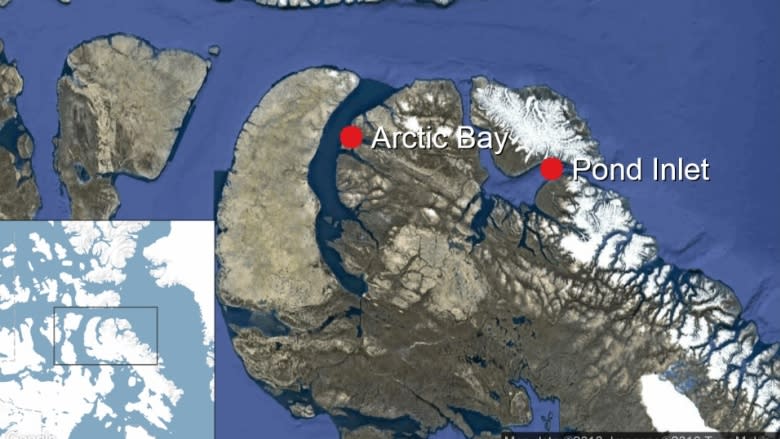Nunavut hunters in 'disbelief' over government's attempt to cut narwhal harvest
Hunters in Pond Inlet say they "don't believe" the government's most recent scientific survey of narwhals, and are upset at the recent recommendation to cut the total allowable harvest by more than a hundred.
Fisheries and Oceans Canada has put forth a recommendation to the Nunavut Wildlife Management Board to cut the quota from the current 236 narwhals, to 134.
"The Inuit here in Pond Inlet don't believe the survey they have brought to us," said Jacolaasie Killiktee, with the Pond Inlet Hunters and Trappers Association, in Inuktitut.
The suggestion was based on a 2013 aerial survey done by government scientists in Eclipse Sound, the waterway around Pond Inlet.
Fisheries and Oceans Canada said the number of narwhals counted in Eclipse Sound in 2013 was 10,500, down from an estimated 20,200 in 2004.
"The people originally from this area know the narwhals more than those research numbers. So we don't believe what the [Department of Fisheries and Oceans] is saying to us," said Killiktee.
Meanwhile, the department has recommended an increase in total allowable harvest from 233 to 389 in Admiralty Inlet, near the Nunavut hamlet of Arctic Bay. Scientists counted almost twice the number of narwhals there since 2010, from 18,100 to 35,000.
The wildlife board held a public hearing last week in Pond Inlet for all affected parties — including scientists from the department who could answer technical questions about the survey.
Daniel Shewchuk, chairperson of the board, said reconciling the scientific and traditional voices "is not going to be easy."
"It's very difficult," said Shewchuk. But he said the traditional Inuit knowledge provided is "very, very positive and powerful information... and it has to be weighed. Just like any other information."
The board's decision will be made and submitted to the minister in the coming months, according to Fisheries and Oceans Canada.
Scientific method in 'early stages' and 'uncertain'
The area that scientists observe "is really huge," according to Steven Ferguson, a scientist with Fisheries and Oceans Canada who was a part of the process of surveying the narwhals in 2013.
"You know, about 200,000 narwhals, and it's distributed all across the Arctic," said Ferguson. "So it's a bit of a challenge for us to do this survey. They're really expensive and require a lot of people to do them."
His team uses large planes to fly over specific areas where narwhals are found; two observers are at the front and two at the back of the plane, counting the narwhals. The plane also has a camera that takes photographs for counting afterwards.
Ferguson said that the result of the 2013 count doesn't necessarily mean that the population of narwhals decreased in the area.
"If we don't have very many survey counts, that means we don't really understand the population too well," said Ferguson.
"We were kind of stuck right now, with having to provide these estimates based on the most recent aerial survey," said Ferguson. "They have a certain amount of uncertainty around them… From one survey to another, the numbers can be fairly different and this causes some confusion."
He said the department is planning on increasing the frequency of their aerial surveys for more "confidence" and better estimates in the future.
"So we're, right now, in the early stages," he said.



